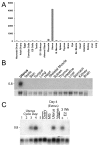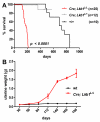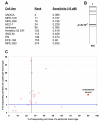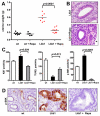Lkb1 inactivation is sufficient to drive endometrial cancers that are aggressive yet highly responsive to mTOR inhibitor monotherapy
- PMID: 20142330
- PMCID: PMC2869492
- DOI: 10.1242/dmm.004440
Lkb1 inactivation is sufficient to drive endometrial cancers that are aggressive yet highly responsive to mTOR inhibitor monotherapy
Abstract
Endometrial cancer--the most common malignancy of the female reproductive tract--arises from the specialized epithelial cells that line the inner surface of the uterus. Although significant advances have been made in our understanding of this disease in recent years, one significant limitation has been the lack of a diverse genetic toolkit for the generation of mouse models. We identified a novel endometrial-specific gene, Sprr2f, and developed a Sprr2f-Cre transgene for conditional gene targeting within endometrial epithelium. We then used this tool to generate a completely penetrant Lkb1 (also known as Stk11)-based mouse model of invasive endometrial cancer. Strikingly, female mice with homozygous endometrial Lkb1 inactivation did not harbor discrete endometrial neoplasms, but instead underwent diffuse malignant transformation of their entire endometrium with rapid extrauterine spread and death, suggesting that Lkb1 inactivation was sufficient to promote the development of invasive endometrial cancer. Mice with heterozygous endometrial Lkb1 inactivation only rarely developed tumors, which were focal and arose with much longer latency, arguing against the idea--suggested by some prior studies--that Lkb1 is a haploinsufficient tumor suppressor. Lastly, the finding that endometrial cancer cell lines were especially sensitive to the mTOR (mammalian target of rapamycin) inhibitor rapamycin prompted us to test its efficacy against Lkb1-driven endometrial cancers. Rapamycin monotherapy not only greatly slowed disease progression, but also led to striking regression of pre-existing tumors. These studies demonstrate that Lkb1 is a uniquely potent endometrial tumor suppressor, but also suggest that the clinical responses of some types of invasive cancers to mTOR inhibitors may be linked to Lkb1 status.
Figures







Similar articles
-
A genetic mouse model of invasive endometrial cancer driven by concurrent loss of Pten and Lkb1 Is highly responsive to mTOR inhibition.Cancer Res. 2014 Jan 1;74(1):15-23. doi: 10.1158/0008-5472.CAN-13-0544. Epub 2013 Dec 9. Cancer Res. 2014. PMID: 24322983 Free PMC article.
-
Stromal liver kinase B1 [STK11] signaling loss induces oviductal adenomas and endometrial cancer by activating mammalian Target of Rapamycin Complex 1.PLoS Genet. 2012;8(8):e1002906. doi: 10.1371/journal.pgen.1002906. Epub 2012 Aug 16. PLoS Genet. 2012. PMID: 22916036 Free PMC article.
-
Loss of Lkb1 provokes highly invasive endometrial adenocarcinomas.Cancer Res. 2008 Feb 1;68(3):759-66. doi: 10.1158/0008-5472.CAN-07-5014. Cancer Res. 2008. PMID: 18245476
-
Dysregulation of mTOR activity through LKB1 inactivation.Chin J Cancer. 2013 Aug;32(8):427-33. doi: 10.5732/cjc.013.10086. Epub 2013 May 14. Chin J Cancer. 2013. PMID: 23668926 Free PMC article. Review.
-
New inhibitors of the mammalian target of rapamycin signaling pathway for cancer.Expert Opin Investig Drugs. 2010 Aug;19(8):919-30. doi: 10.1517/13543784.2010.499121. Expert Opin Investig Drugs. 2010. PMID: 20569080 Review.
Cited by
-
LKB1-AMPK axis revisited.Cell Res. 2012 Dec;22(12):1617-20. doi: 10.1038/cr.2012.108. Epub 2012 Jul 17. Cell Res. 2012. PMID: 22801477 Free PMC article.
-
Reversal of obesity-driven aggressiveness of endometrial cancer by metformin.Am J Cancer Res. 2019 Oct 1;9(10):2170-2193. eCollection 2019. Am J Cancer Res. 2019. PMID: 31720081 Free PMC article.
-
Unravelling the connection between metabolism and tumorigenesis through studies of the liver kinase B1 tumour suppressor.J Carcinog. 2013 Aug 8;12:16. doi: 10.4103/1477-3163.116323. J Carcinog. 2013. PMID: 24082825 Free PMC article. Review.
-
Axons hooked to Schwann cell metabolism.Nat Neurosci. 2014 Oct;17(10):1293-5. doi: 10.1038/nn.3825. Nat Neurosci. 2014. PMID: 25254976 No abstract available.
-
Liver kinase B1 (LKB1) in the pathogenesis of epithelial cancers.Cancer Lett. 2011 Jul 1;306(1):1-9. doi: 10.1016/j.canlet.2011.01.014. Epub 2011 Mar 29. Cancer Lett. 2011. PMID: 21450399 Free PMC article. Review.
References
-
- Alessi DR, Sakamoto K, Bayascas JR. (2006). Lkb1-dependent signaling pathways. Annu Rev Biochem. 75, 137–163 - PubMed
-
- Barakat RR, Grigsby PW, Sabbatini P, Zaino RJ. (2000). Corpus: Epithelial Tumors (in Principles and Practice of Gynecologic Oncology). Philadelphia: Lippincott Williams and Wilkins
Publication types
MeSH terms
Substances
Grants and funding
LinkOut - more resources
Full Text Sources
Other Literature Sources
Molecular Biology Databases
Miscellaneous

